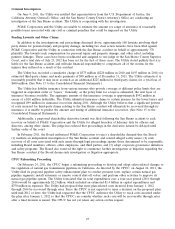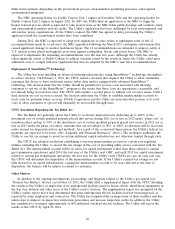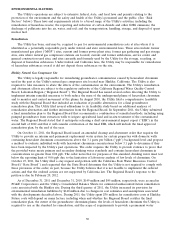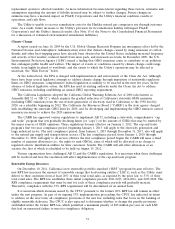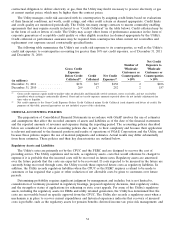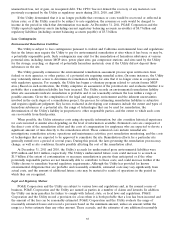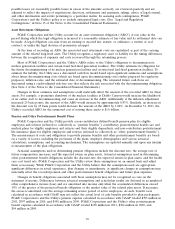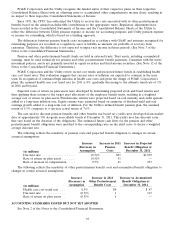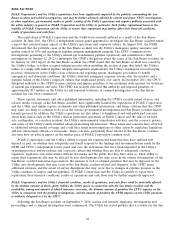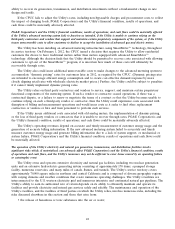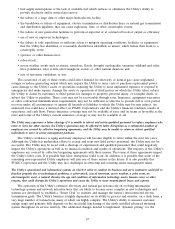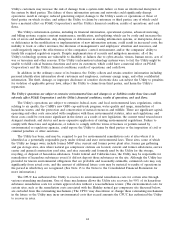PG&E 2011 Annual Report Download - page 39
Download and view the complete annual report
Please find page 39 of the 2011 PG&E annual report below. You can navigate through the pages in the report by either clicking on the pages listed below, or by using the keyword search tool below to find specific information within the annual report.unamortized loss, net of gain, on reacquired debt. The CPUC has not denied the recovery of any material costs
previously recognized by the Utility as regulatory assets during 2011, 2010, and 2009.
If the Utility determined that it is no longer probable that revenues or costs would be recovered or reflected in
future rates, or if the Utility ceased to be subject to rate regulation, the revenues or costs would be charged to
income in the period in which that determination was made. At December 31, 2011, PG&E Corporation and the
Utility reported regulatory assets (including current regulatory balancing accounts receivable) of $8.7 billion and
regulatory liabilities (including current balancing accounts payable) of $5.3 billion.
Loss Contingencies
Environmental Remediation Liabilities
The Utility is subject to loss contingencies pursuant to federal and California environmental laws and regulations
that in the future may require the Utility to pay for environmental remediation at sites where it has been, or may be,
a potentially responsible party. Such contingencies may exist for the remediation of hazardous substances at various
potential sites, including former MGP sites, power plant sites, gas compressor stations, and sites used by the Utility
for the storage, recycling, or disposal of potentially hazardous materials, even if the Utility did not deposit those
substances on the site.
The Utility generally commences the environmental remediation assessment process upon notification from
federal or state agencies, or other parties, of a potential site requiring remedial action. (In some instances, the Utility
may voluntarily initiate action to determine its remediation liability for sites that it no longer owns in cooperation
with regulatory agencies. For example, the Utility has begun a voluntary program related to certain former MGP
sites.) Based on such notification, the Utility completes an assessment of the potential site and evaluates whether it is
probable that a remediation liability has been incurred. The Utility records an environmental remediation liability
when site assessments indicate remediation is probable and it can reasonably estimate the loss within a range of
possible amounts. Given the complexities of the legal and regulatory environment and the inherent uncertainties
involved in the early stages of a remediation project, the process for estimating remediation liabilities is subjective
and requires significant judgment. Key factors evaluated in developing cost estimates include the extent and types of
hazardous substances at a potential site, the range of technologies that can be used for remediation, the
determination of the Utility’s liability in proportion to other responsible parties, and the extent to which such costs
are recoverable from third parties.
When possible, the Utility estimates costs using site-specific information, but also considers historical experience
for costs incurred at similar sites depending on the level of information available. Estimated costs are composed of
the direct costs of the remediation effort and the costs of compensation for employees who are expected to devote a
significant amount of time directly to the remediation effort. These estimated costs include remedial site
investigations, remediation actions, operations and maintenance activities, post remediation monitoring, and the costs
of technologies that are expected to be approved to remediate the site. Remediation efforts for a particular site
generally extend over a period of several years. During this period, the laws governing the remediation process may
change, as well as site conditions, thereby possibly affecting the cost of the remediation effort.
At December 31, 2011 and 2010, the Utility’s accruals for undiscounted gross environmental liabilities were
$785 million and $612 million, respectively. The Utility’s undiscounted future costs could increase to as much as
$1.5 billion if the extent of contamination or necessary remediation is greater than anticipated or if the other
potentially responsible parties are not financially able to contribute to these costs, and could increase further if the
Utility chooses to remediate beyond regulatory requirements. Although the Utility has provided for known
environmental obligations that are probable and reasonably estimable, estimated costs may vary significantly from
actual costs, and the amount of additional future costs may be material to results of operations in the period in
which they are recognized.
Legal and Regulatory Matters
PG&E Corporation and the Utility are subject to various laws and regulations and, in the normal course of
business, PG&E Corporation and the Utility are named as parties in a number of claims and lawsuits. In addition,
the Utility can incur penalties for failure to comply with federal, state, or local laws and regulations. PG&E
Corporation and the Utility record a provision for a loss when it is both probable that a loss has been incurred and
the amount of the loss can be reasonably estimated. PG&E Corporation and the Utility evaluate the range of
reasonably estimated losses and record a provision based on the minimum amount, unless an amount within the
range is a better estimate than any other amount. These accruals, and the estimates of any additional reasonably
35




